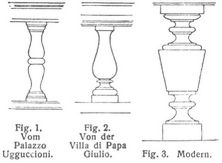Baluster — in der Haupttreppe vom Nationalmuseum in Prag (Kalkstein Adneter Rotscheck) Der Baluster (ital. balaustro von griech. balaustion: Granatapfel) ist die niedrige Einzelsäule einer Balustrade. Meist haben Baluster eine runde Form, es gibt jedoch… … Deutsch Wikipedia
baluster — baluster, banister The OED describes banister as a corruption of the slightly earlier word baluster; both are 17c. A baluster, though once having the meaning that banisters (plural) now has, means a single curved or ornamental post supporting a… … Modern English usage
Baluster — Bal us*ter, n. [F. balustre, It. balaustro, fr. L. balaustium the flower of the wild pomegranate, fr. Gr. balay stion; so named from the similarity of form.] (Arch.) A small column or pilaster, used as a support to the rail of an open parapet, to … The Collaborative International Dictionary of English
Baluster — (franz. balustre, v. griech. balaustion, »unreife Granatfrucht«), ein schwellend länglichrunder Körper, besonders in der Baukunst ein stark geschwelltes, glattes oder verziertes, meist reich profiliertes Säulchen oder überhaupt ein Zwergsäulchen … Meyers Großes Konversations-Lexikon
baluster — support for a railing, c.1600, from Fr. balustre, from It. balaustro pillar, from balausta flower of the wild pomegranate, from Gk. balaustion (perhaps of Semitic origin, Cf. Aramaic balatz flower of the wild pomegranate ). Staircase uprights had … Etymology dictionary
baluster — ► NOUN ▪ a short pillar forming part of a series supporting a rail. ORIGIN from Italian balaustra wild pomegranate flower (because of the resemblance to part of the flower) … English terms dictionary
baluster — [bal′əs tər] n. [Fr balustre < It balaustro, pillar < balausta, flower of the wild pomegranate < L balaustium < Gr balaustion: from some resemblance in shape] any of the small posts that support the upper rail of a railing, as on a… … English World dictionary
Baluster — A baluster (according to OED derived through the French balustre , from Italian balaustro , from balaustra , pomegranate flower [from a resemblance to the swelling form of the half open flower ( illustration, below left )] , [The early sixteenth… … Wikipedia
baluster — [17] Etymologically, baluster and banister are the same word. Both come ultimately from Greek balāustion ‘pomegranate flower’, which reached English via Latin balaustium, Italian balaustro, and French balustre. The reason for the application of… … The Hutchinson dictionary of word origins
balúster — tra m (ú) arhit. modeliran stebriček v ograji: kamnit baluster … Slovar slovenskega knjižnega jezika

